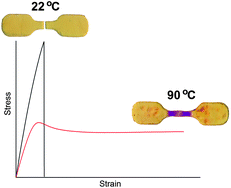Environmental effects on mechanochemical activation of spiropyran in linear PMMA†
Abstract
Mechanophore-linked linear

- This article is part of the themed collection: Mechanoresponsive materials
* Corresponding authors
a Department of Materials Science and Engineering, University of Illinois at Urbana-Champaign, 1304 W. Green Street, Urbana, IL, USA
b
Beckman Institute for Advanced Science and Technology, 405 N. Matthews Avenue, Urbana, IL, USA
E-mail:
swhite@illinois.edu
c Department of Chemistry, University of Illinois at Urbana-Champaign, 505 S. Matthews Avenue, Urbana, IL, USA
d Department of Aerospace Engineering, University of Illinois at Urbana-Champaign, 104 S. Wright Street, Urbana, IL, USA
Mechanophore-linked linear

 Please wait while we load your content...
Something went wrong. Try again?
Please wait while we load your content...
Something went wrong. Try again?
B. A. Beiermann, D. A. Davis, S. L. B. Kramer, J. S. Moore, N. R. Sottos and S. R. White, J. Mater. Chem., 2011, 21, 8443 DOI: 10.1039/C0JM03967E
To request permission to reproduce material from this article, please go to the Copyright Clearance Center request page.
If you are an author contributing to an RSC publication, you do not need to request permission provided correct acknowledgement is given.
If you are the author of this article, you do not need to request permission to reproduce figures and diagrams provided correct acknowledgement is given. If you want to reproduce the whole article in a third-party publication (excluding your thesis/dissertation for which permission is not required) please go to the Copyright Clearance Center request page.
Read more about how to correctly acknowledge RSC content.
 Fetching data from CrossRef.
Fetching data from CrossRef.
This may take some time to load.
Loading related content
